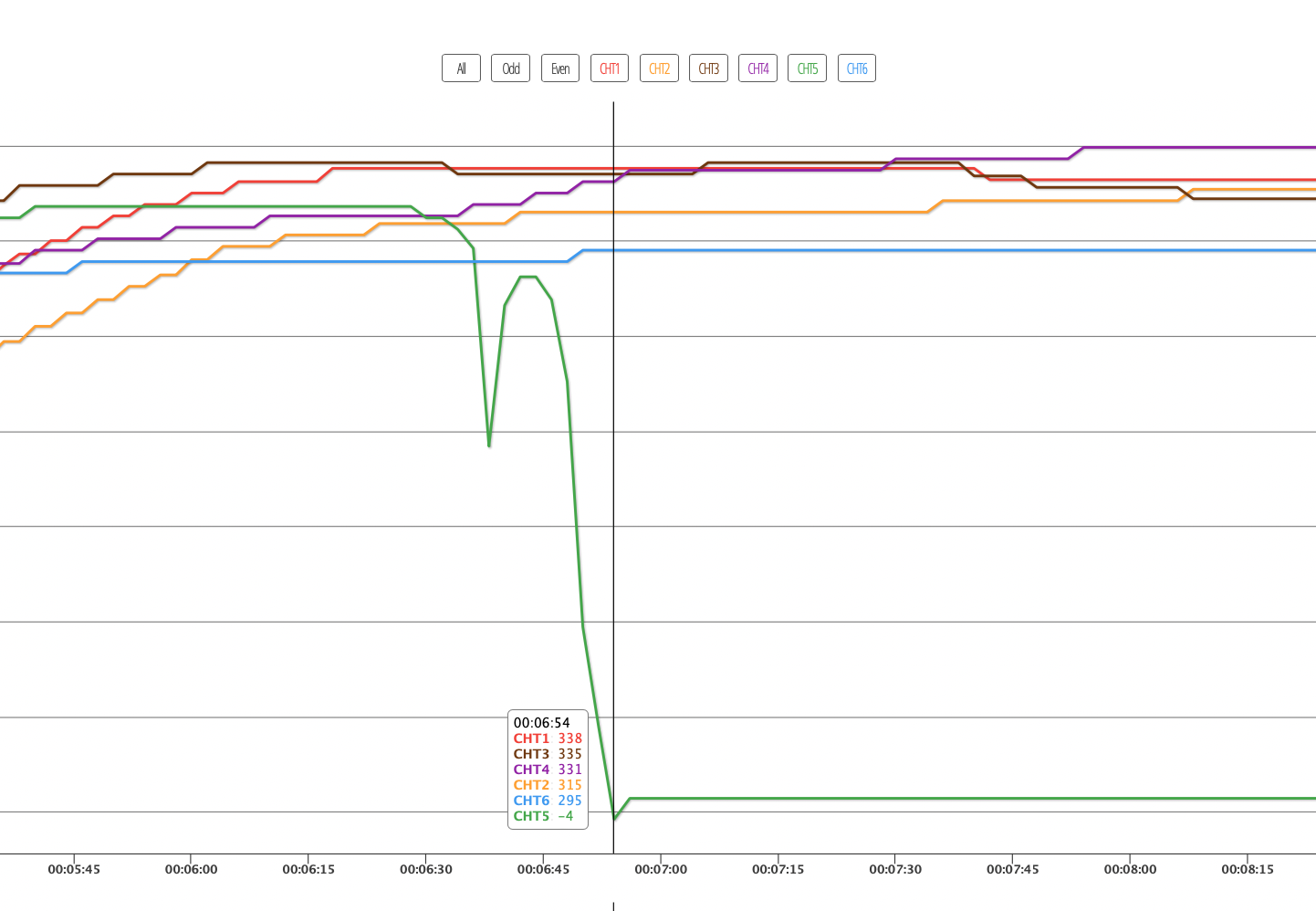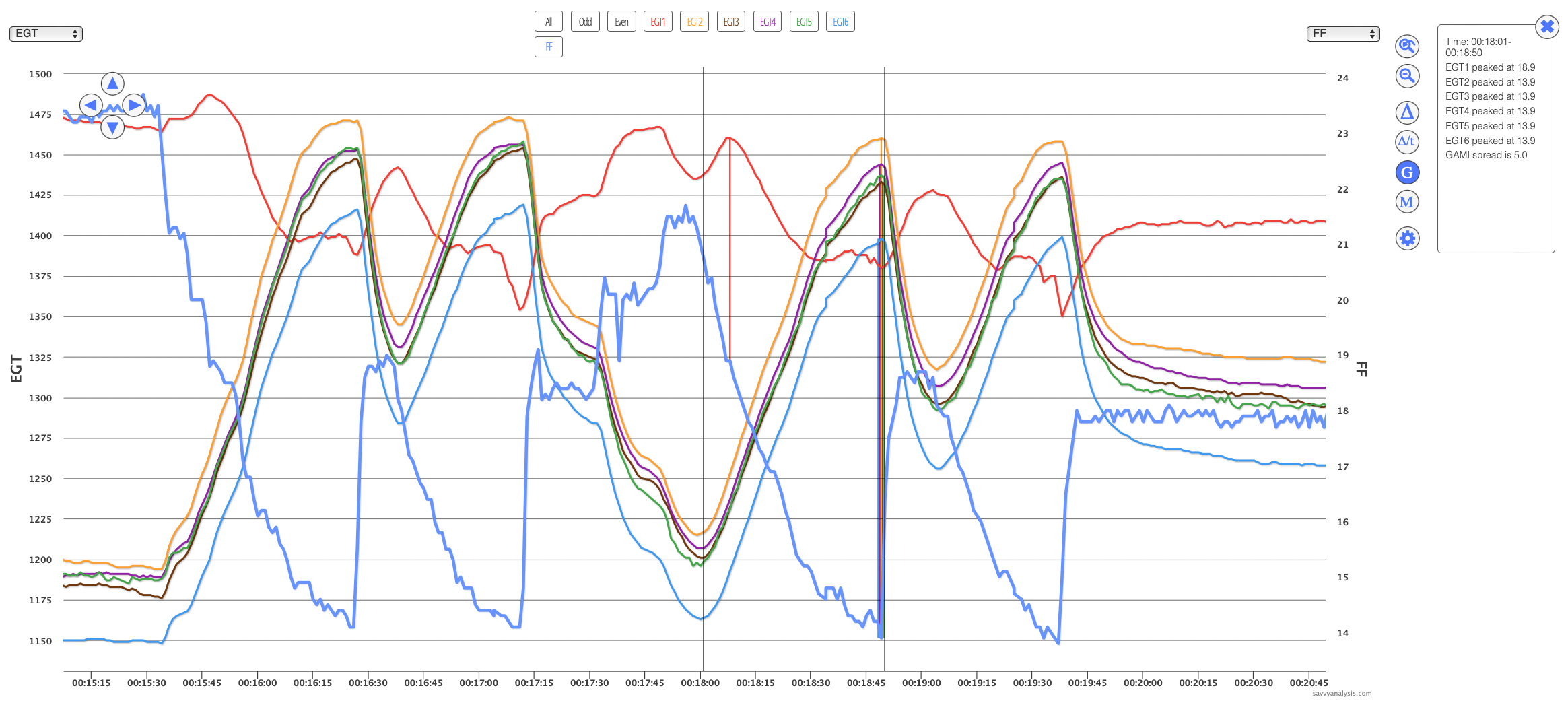When you’re flying and inadvertently run a tank dry, or the cabin door pops open, or you smell smoke, or any similar unexpected threat, the part of your brain that listened to your CFI — train like you fly and fly like you train — goes to work. Your lizard brain also goes to work, and may not see things the same way. What if the unexpected event is something in the engine data? No smoke, no vibration, all is normal except one of the CHTs is now displaying zero.
Sometimes data helps us make informed decisions about powerplant management and safety of flight. Sometimes it saves us money in unnecessary maintenance. But sometimes it’s lying.
We’ll start this month with data from a Cessna 172XP powered by a Continental IO-360 and data from a JPI 830 with a 2 sec sample rate. This is the standard layout of EGTs, CHTs, and FF.

It looks like we have two issues to consider – and let’s consider them from the pilot’s perspective. Just after engine start, EGTs 1 and 2 are low. CHTs 1 and 2 start slightly low then slowly warm, but not like the other four. This is consistent with data from recent starts, and the pattern is they stay low through taxi-out and runup and always join the others when takeoff power is applied.
Idle MAP is 15″ which is high enough to suspect an induction leak, but sleeves and clamps were checked and are all tight. It’s probably going to take the soapy water test or a smoke test to find a leak. Maybe at the next annual. The good news is it doesn’t look like two simultaneous sticky valves, which would be rare on any engine and especially this Continental 360. It also doesn’t look like a worn cam lobe because it looks normal at high power, and the cam would be worn whether spinning fast or slow. So we’re willing to take this non-ideal scenario into the air, because if it’s like before, it will look normal as soon as we hit the power.
So we takeoff at about the 5 min mark in the timeline, lean a little bit for initial climb, and just as we settle on the climb mixture setting, CHT 5 starts moving. It drops, it climbs, then it drops and stays there. That all happened pretty fast, so maybe we were looking for traffic and missed all that. Anyway, it’s low now – showing 7º. Not 0º – which would sort of make sense, but 7º. Lizard brain doesn’t like this.
Meanwhile the fly/train brain looks at EGT 5 and sees nothing unusual. Oil pressure and temp are normal. The engine is humming. There’s something unsettling about it settling on 7º, but a jumpy CHT would be even more distracting. So we press on – after all it’s just a 12 minute hop across town. Then when we start the approach at about 13 mins with a slight power reduction, CHT 5 is back to normal. Now you have a second startle response.
Lizard brain stops worrying, but rational fly/train brain now wonders if we can trust anything that CHT 5 shows us. Reviewing the data shows that the big drop went past 7º to -4º, before settling at 7º, but chances are slim that you’d notice that in real time.

Given that the data stops flowing approximately when the nose gets pushed over for cruise and speed increases, and starts flowing again when power is configured for approach, you can’t rule out a loose connection. It always makes sense to check the connection first, but this one looks like a probe failure.
Next up is a Bonanza A36 with a Continental IO-550 and data from an Insight G3 with a 1 sec sample rate. EGTs. CHTs and FF. Nothing special about the cursor placement – just getting it out of the way.

Let’s continue reviewing the data from the pilot’s perspective, starting with engine start and taxi-out. Let’s zoom in and add oil temp and pressure in the bottom rank.

Nothing startling in EGTs, CHTs, FF and oil pressure. Oil temp, on the other hand, is a problem. Lizard brain can’t even count that high but knows that four digits is too many. Rational brain takes over and notes that the nice thing about oil temp at 3300º is that you don’t spend much time questioning its validity. Let’s give the actual pilot of this flight the benefit of the doubt and stipulate that there was a legacy oil temp gauge on board giving reliable readings in a normal range. With that out of the way, nothing else we’ve seen so far suggests we should scrub the flight.
Takeoff is normal and as we climb EGT and CHT 1 just keep climbing, eventually peaking at 1563º and 401º respectively. The FF reduction at 8 mins brings them down a little, but both are still very high. Whatever lizard brain might be thinking, rational brain performs a series of rich-to-lean mixture sweeps.

Visually, EGT 1 peaks well ahead of the others, Numerically it calculates to 5.0 GPH. That’s injector clog hall of fame numbers. Regular puzzler readers will remember that high EGT and CHT at max power is half of the symptoms of an injector clog – the other half is lower EGT and CHT when FF is reduced to LOP. Going back to the screenshot of the whole flight, we see that happen after the sweeps – although EGT didn’t fall as much as we’d expect. There might be an issue with spark keeping EGT 1 high even at lower FF.
Meanwhile, oil temp has down-spiked three times into the 2300º range. Thanks but we’re good – we already resolved our oil temp startle before takeoff. So far we’ve seen two examples of something real and corroborated, along with something impossible.
Next up is an early-model Cirrus SR20 with a Continental IO-360 and data from an Avidyne Entegra. EGTs, CHTs, FF, then Oil temp and oil pressure.

Cursor is on oil temp at -67º just before it wakes up, and then it’s ok until shutdown. Meanwhile, EGT 6 was high from the get-go, while CHT 6 is on the high side but not an outlier. Imagine you’re in the left seat. Does anything you see up to the 13 min mark concern you enough to scrub the flight? Let’s press on.
Here’s the data zoomed in from takeoff power until shutdown.

Cyl 6 makes power until FF reaches 4.5 GPH, then it starts shutting down. Groundspeed and altitude aren’t logged, so we don’t know how far into the takeoff roll this was. This “startle” evolved over about 30 seconds, and the airplane was probably well into initial climb by then. By 14:45 – 45 secs after the takeoff roll started – cyl 6 isn’t making power anymore.
Just after 17 mins, as FF is reduced, cyl 6 comes back to life, and that had to be a bit of a startle, too. Then when FF is increased just a little at 17:30, cyl 6 drops off again, and comes back yet again as FF is reduced. This time it stays in the game. Reviewing the data, it’s easy to see that cyl 6 didn’t like FF higher than 4.5 but was ok below that.
Which had us wondering why didn’t cyl 6 just take the 4.5 it could handle and make whatever power it could with that – from 14 to 17 mins. The answer must be that with MAP so high, 4.5 GPH was too much air / not enough gas to generate combustion.
If the Bonanza injector was hall of fame material, this one has to go in, too.